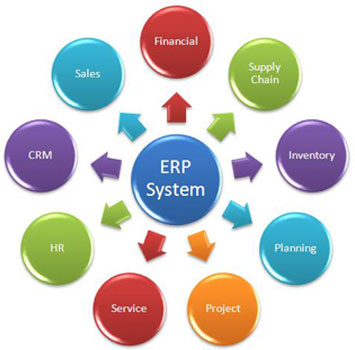
Our business softwares carry out potential business operations with a tendency to fasten up simple routine jobs keeping aside any manual lethargies. Any organisation demands a systematic approach for hierarchy management with no interruption in the flow of information. The foundation of all our digital inventions, is to permit efficient workflow without being puzzled in the multi dimensional departments.
Our ERP methodologies survey across all the segments of the business covering sales, marketing, inventory, back-end and admin. The reports and analytics are digitally connected to all the inter linking teams to produce a one-glance view of your current management and financial status. We assure you the best view of your own organisation starting from bird’s eye view of all teams and an in-depth pivot and research report that can serve as a base for goal oriented long term decisions and changes.
Accounting is the preparation and analysis of financial records, such as income statements, balance sheets, and cash flows. Accountants use the data collected and recorded by bookkeepers to assess the financial health of a company, to prepare a company's tax forms, and to help the business's functions, such as marketing and IT, decide how much money to spend on the items they need, such as advertising and computer equipment. ERP is designed to help businesses accurately record financial transactions, such as sales and expenses, so they know exactly how much money is coming into and going out of the business. It supports the bookkeeping, accounting, and finance functions of a small business by making it easy to record transactions and to produce accurate financial reports.
Project management tool has the capacity to help plan, organize, and manage resource pools and develop resource estimates. Depending on the sophistication of the software, it can manage estimation and planning, scheduling, cost control and budget management, resource allocation, collaboration software, communication, decision-making, quality management and documentation or administration systems. It provides information to various people or stakeholders, and can be used to measure and justify the level of effort required to complete the project(s). This tool provides
- Overview information on how long tasks will take to complete.
- Early warning of any risks to the project.
- Information on workload, for planning holidays.
- Evidence.
- Historical information on how projects have progressed, and in particular, how actual and planned performance are related.
- Optimum utilization of available resource.
- Cost maintenance.
- Collaboration with each teammates and customers.
- Instant communication to collaborators and customers.
Supply Chain Management focuses on all of the integrated aspects which are contained in the entire supply chain from the first supplier to the end customer and it aims to integrate all key business processes throughout the entire supply chain. It revolves around efficient integration of suppliers, manufacturers, warehouses, and stores, it encompasses the firm’s activities at many levels, from the strategic level through the tactical to the operational level. The primary objectives are
